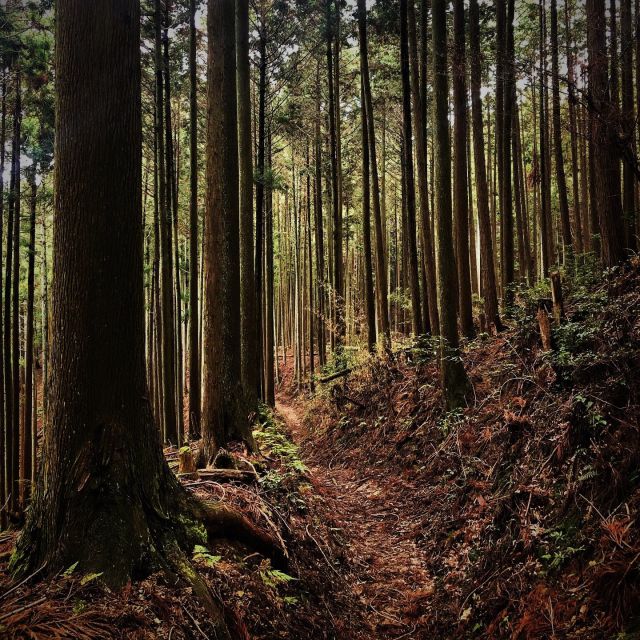
Shinrin Yoku and Oni Fest at Yoshinoyama
The forest of Yoshinoyama; for sure one of the most magical places I’ve ever been. I went there in February 2020 because I was looking for a way to find a connection with nature again. I stayed for three nights in ゲストハウス (Japanese for guesthouse) KAM INN, to learn from guesthouse owner Fumie about Shugendō 修験道. I was highly interested in this nature religion (developed in the Heian period 794 to 1185 AD) because it is a fusion of Shinto 神道 mountain worship and Buddhism.
Fumie is a Yamabushi 山伏; a practitioner of Shugendō and she told me marvelous stories about their harsh mountain training. She spoke of the deep intelligence of the forest, and magical creatures like Kodama 木霊, Yōkai 妖怪, and Oni 鬼. I had the honor to join her during the morning prayers in the main Shugendō temple: Kimpusen-ji, a magnificent wooden building, supported by giant logs in the main hall. Next time I visit, I'll make sure my Japanese is better to understand what the prayers are about.
Fumie: "The forest knows everything, we only have to listen"
One of the locals told me about a special forest therapy road, known as Shinrin-Yoku 森林浴 - forest bathing - to heal and cleanse body and soul. So after the morning prayer, I wandered the ancient mountain forest of Yoshinoyama, full of huge pine trees covered with the greenest moss I’d ever seen. Passing crystal clear mountain streams and small shrines and temples of mountain and water gods. It was so silent, the only thing I could hear was my breathing; which made it a deep meditative experience.
That same evening, I was very lucky to participate Oni fest in the small mountain village. On this famous ‘Bean-Throwing Festival’ also known as ‘Setsubun’ 節分, kids throw roasted soybeans at family members dressed up in blue and red Oni suits. They believe the beans scare away evil spirits that bring bad health and misfortune. But in contrast to most regions, in Yoshinoyama demons are invited in the houses, restaurants, and temples. Instead of shouting “Oni wa soto! Fuku wa uchi! 鬼は外! 福は内! (Devils out! Fortune in!) they shout “Oni mo uchi! 鬼も内": "Demons, also come in"! The locals told me this is because of an Oni legend in Yoshinoyama that teaches them to embrace their inner demons. That must be why I ended up at the ‘after party’ drinking beers with the Onis and hilarious tipsy monks of Kimpusen-ji while listening to their beloved Beatles records.
Traditional Japanese culture is deeply connected with nature. Shinto religion sees gods (Kami 神) in rivers, mountains, and trees. In Shugendō for example, they pray to the river god, who creates fertile woods. The forest gives them oxygen, food, and wood for their houses and temples.
In his book ‘Shinrin-Yoku: The Art and Science of Forest Bathing’, Dr. Qing Li tells us that in the year 2000 humans officially became an urban species. Europeans spend 90% of their days inside, mostly behind screens. We don’t have to forage, hunt, or get our hands dirty anymore. We forgot our health depends on the health of nature.
Before covid hit The Netherlands, I saw an average of 50 people a day in my yoga and meditation classes. A big part of them came to class to heal from burn-out, depression, repetitive strain injury, irritated bowel syndrome, and many other mental and physical diseases caused by our disconnection from nature and addiction to technology. In 1984 we even made up a word for this health problem: ‘Technostress’.
In 1982 Japan introduced a national health program for forest bathing in Akasawa forest, on the old Nakasendo route, well known as the Samurai Trail. Tomohide Akiyama coined the term ‘Shinrin-Yoku’ because Japanese people needed healing by nature and the forests needed protection.
“The more people feel they need nature for their health, the more they will protect and take care of the forests instead of destroying them.”
In 2005 Dr. Qing Li scientifically proved a single two-hour session of Shinrin-Yoku a month is enough to increase the activity of our natural killer cells. These are a type of white blood cells that attack unwanted cells infected with a virus or tumor cells. This is caused by the phytoncides (natural oils) that trees diffuse to protect themselves against bacteria, insects, and fungi.
One of the most famous and loved trees in Japan is the Hinoki cypress. Its high-quality wood is used for palaces, temples, shrines, onsen baths, and masu for centuries. Dr. Qing Li teaches us the phytoncides of the Hinoki cypress can activate our natural killer cells, lower stress hormones, increase sleep, and lower our feelings of tension, fear, anger, or fatigue. Other researchers have demonstrated phytoncides can suppress the activity of our sympathetic nervous system (fight or flight response) and increase the activity of our parasympathetic nervous system (rest-and-digest), which relaxes body and mind.
Soon I’ll write a lot more about the magic of nature and how we can use ancient Japanese wisdom to uplift our daily lives. But for now, let’s talk about what we can do to rekindle our connection with nature: Block your agenda for a monthly silent two-hour walk in the forest, using all your senses. Next to that, you can spread phytoncides at home by putting a few drops of essential oils from the forest in your diffuser. Be sure you buy pure organic oils from for example pine, cedar, fir, or cypress. And/or join my yearly Japanese Yoga according to the Seasons online course!